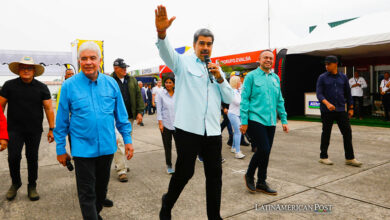The Andrés Manuel López Obrador government's proposal seeks to stop migration and climate change. What does all this imply?.

According to the UN, the impact of the climate crisis in the modern era caused more and more people to decide to migrate, due to meteorological phenomena that impact on the life and activity of human beings. Photo: Pixabay
LatinAmerican Post | Ariel Cipolla
Listen to this article
Leer en español: ¿Qué tan viable es la propuesta de AMLO de sembrar árboles para frenar la crisis migratoria?
Climate change is on the agenda of most of the countries on the planet that seek to incorporate policies in order to slow down the impact of man on Earth. According to the UN, the impact of the climate crisis in the modern era generates that more and more people decide to migrate, due to meteorological phenomena that impact the life and activity of human beings.
According to the Internal Displacement Monitoring Center, some 17.2 million people had to leave their homes in just one year worldwide, due to the different natural disasters that derive from poor environmental care and poor living conditions in certain regions.
So some nations have plans to prevent migration. According to the Chicago Tribune, Mexico will propose to the United States to plant trees in the south of the country and Central America to avoid uncontrolled migration, through an investment that will mean about 1,400 million dollars, in a plan known as Sembrando Vida.
Trees and the problem of migration
President Andrés Manuel López Obrador proposed to the President of the United States, Joe Biden, the possibility of planting trees throughout the Central American region, a plan that will also have the objective of “generating jobs” and helping the environment. The idea of the Mexican president has three important components to be able to control migration:
- Generate employment: for AMLO, if green jobs are created at the source of migration , this could reactivate the local economy and generate greater opportunities.
- Putting the applications in order: the people who enter the tree growing projects can enter a migratory process of 3 years in the future, with facilities.
- Reduce migration due to natural disasters: with the planting of millions of trees, we seek to reduce the force and destruction of natural disasters related to climate change and deforestation.
López Obrador emphasized the possibility of generating agreements for governments to support planting for about three years. After obtaining crops, workers would be entitled to a six-month work visa in the United States. They could even apply for US citizenship, which would allow ordering the migratory flow.
AMLO le pedirá a Biden visas de trabajo para quienes planten árboles en México y en Centroamérica, inclusive el que puedan solicitar la nacionalidad estadounidense https://t.co/SmcWTXmd2F
???? Gobierno de México pic.twitter.com/WvBrsC5ORo
— Forbes México (@Forbes_Mexico) April 18, 2021
In the Mexican case, the idea is to plant millions of trees that also facilitate the possibility of providing "thousands of jobs" and that migration to the United States is avoided. For the moment, López Obrador indicated that in his territory they are planting a million hectares (with fruit, citrus, cocoa and coffee plantations, among others) that create more than 400 thousand jobs, which would serve to improve the economic situation of some regions, such as Campeche, Veracruz, Oaxaca, Tabasco and Chiapas.
At the same time, as we mentioned, the Sembrando Vida plan has a strongly ecological objective: it will try to reforest more than one million hectares in deteriorated land in Mexico, to cultivate more than 1,000 million plants that help improve the environmental conditions of the area. and, consequently, to improve the quality of life of the population, since both factors are strongly related.
According to the International Organization for Migration (IOM), the triggers of climate change also affect the politics and economy of many countries in terms of migration. For example, the increasing frequency and intensity of natural disasters, climate variability or scarcity of resources, and economic problems make people decide or are forced to leave their countries of origin.
Also read: Save Ralph: This is how animal testing works in Latin America
Let us remember that many states adapted to different historical agreements, such as the Global Compact for Migration, the Sendai Framework for Disaster Risk Reduction, and the Paris Agreement on Climate Change. All of them aim to minimize the adverse and structural factors that cause many people to leave their country of origin.
In addition to reducing the problem of migration, the International Labor Organization, in its report Social and employment perspectives in the world, mentions that the creation of “green jobs” will allow the creation of 24 million jobs during this decade, as long as when appropriate policies are in place.
Para quienes no sepan a qué se van a dedicar, qué tal una carrera en sostenibilidad. De acuerdo con Google los 'empleos sostenibles' han aumentando en un 30% de 2018 a 2020, una economía más verde podría crear 24 millones de empleos en 2030, los 'empleos verdes' van en aumento. pic.twitter.com/RDBuizgile
— Mónica López Alfa 91.3 (@MonyLoOficial) January 5, 2021
The "green jobs" alternative
The most obvious case is that of Lanbide, the Basque Employment Service. Through an alliance between the State and private initiatives, successful models were used to create different kinds of green jobs in the most vulnerable sectors of the region, through different projects presented around the world and chosen by a specialized jury.
Basically, the initiative is aimed at the municipalities with the highest unemployment rate in each Bilbao territory, with the intention of improving the employee rate. Among other works, there is ecotourism, forest management thanks to the planting of trees (something similar to what Mexico intends), the manufacture of packaging products from plant waste, or the generation of solar energy, among others.
In other words, they are all environmentally friendly policies that allow, at the same time, the creation of employment in historically disadvantaged areas, with the aim of avoiding the transfer of premises to other municipalities or countries. Therefore, López Obrador's strategy may seem strange, but it could also be a pioneer in our region to help the environment, generating an approach towards green employment and avoiding migration due to environmental and economic conditions.
However, one of the main problems with this project is that the current migration crisis cannot be solved within 3 years. Many of the migrants are asylum seekers or members of vulnerable groups who will not be able to enter reforestation programs.




